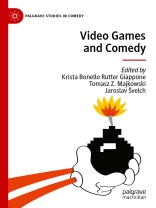Video Games and Comedy is the first edited volume to explore the intersections between comedy and video games. This pioneering book collects chapters from a diverse group of scholars, covering a wide range of approaches and examining the relationship between video games, humour, and comedy from many different angles. The first section of the book includes chapters that engage with theories of comedy and humour, adapting them to the specifics of the video game medium. The second section explores humour in the contexts, cultures, and communities that give rise to and spring up around video games, focusing on phenomena such as in-jokes, player self-reflexivity, and player/fan creativity. The third section offers case studies of individual games or game series, exploring the use of irony as well as sexual and racial humour in video games.
Chapter “Emergence and Ephemerality of Humour During Live Coverage of Large-Scale e Sports Events” is available open access under a Creative Commons Attribution 4.0 International License via link.springer.com.
Tabla de materias
Part 1.Scaffolding and how to fall off it: Theories and concepts.-1. Ludo-Comedic Consonance: An Introduction to Video Games and Comedy.-2. Comedy and the Dual Position of the Player.-3. Press X to Punch(line): The Design and Cognition of Interactive Gags.-4. The Rubber Chicken’s Ergodicity: On Puzzle Punchlines in The Secret of Monkey Island.-5. On Nintendo’s Visual Humour: Slapstick Cinema and Comic Theatre in Super Smash Bros.-6. Benign Trials, Vexing Violations: Reading Humour in Puzzle Games.- Part 2.Clowning Around: Contexts, Cultures, and Communities.- 7. The Illuminatus Space Game: From an April Fools’ Joke to Digital Cultural Heritage.-8. Red Comrades Save the Galaxy: Early Russian Adventure Games and the Tradition of Anecdote.-9. “Sorry, You Had Won”: Satirical French Digital Games Responding to National Sociopolitical Crisis (1984–1986).-10. Making Fun of Tetris: Humour in Parodies of a Computer Game Classic.-11. Ridiculing the Player: Live-Action Visualisations of Game Experience in You Tube Parody Videos as an Ambivalent Strategy of Self-Fashioning.-12. Emergence and Ephemerality of Humour During Live Coverage of Large-Scale e Sports Events.- Part 3. Five Ways to Spoil A Joke: Case Studies.- 13. Cybernetic Irony: Racial Humour from Mecha-Hitler to Nuclear Gandhi.-14. “Mark Matthews Stars in ‘Anatomy is Hard!’ A Struggling Student Tries to Make the Grade with His Professor”: Sexual Humour and Queer Space in Coming Out on Top.-15. “A Tool of Efficiency and Consumption to Destroy Man”: Irony and Sincerity in Travis Strikes Again: No More Heroes.-16. Humour in Pornographic Browser Games: From Undertale to Uddertale, a Case Study.-17. That Joke Isn’t Funny Anymore (Or Is It?): On Hitman and Gamer Humour(lessness)
Sobre el autor
Krista Bonello Rutter Giappone is Visiting Senior Lecturer at the University of Malta, and a Research Fellow with the University of Kent, UK. She has written extensively on comedy, including comedy in video games.
Tomasz Z. Majkowski is Associate Professor at Jagiellonian University in Krakow, Poland, where he teaches and researches games, the carnivalesque and popular culture among other areas.
Jaroslav Švelch is Assistant Professor of media studies at Charles University, Prague, the Czech Republic. A media scholar and linguist by training, his research focuses on game history, humour in video games, and video game monsters. He is the author of Gaming the Iron Curtain (2018), a history of computer gaming in 1980s Czechoslovakia.












